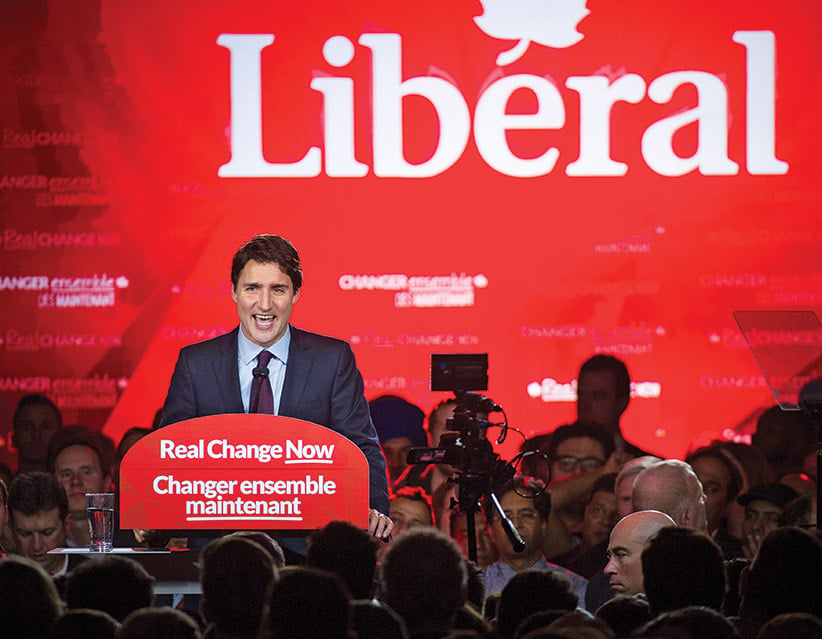What decline? New voters flocked to Liberals
Even where they lost big, Trudeau’s team might smile
Prime minister-designate Justin Trudeau attends his first official news conference at the National Press Theatre in Ottawa, Tuesday Oct.20, 2015. THE CANADIAN PRESS/Adrian Wyld
Share

Two things are obvious about Canada’s election that brought a Liberal government to power. Voter turnout jumped seven per cent to its highest point in a generation. And Liberals won in places they’d lost, gradually and painfully, riding by riding, for most of the last decade. One night reversed years of stubborn decline. Pollsters are already suggesting that even if Justin Trudeau’s team flipped a bunch of votes to gain power, the higher turnout—and all the new or returning votes that came with it—pushed the party over the top.
No one knows yet how many people switched their votes, how many first-timers cast ballots, and how many people turned up after skipping the last election. But we do know that Conservatives, whose percentage of the vote dropped nine points, still won over a similar number of voters—5,835,270 in 2011 vs. 5,600,496 in 2015. That number alone suggests Liberals, whose popular vote jumped by more than four million, got a bunch of apathetic voters to their nearest polling station. The strategy, as Abacus Data’s David Coletto elegantly phrased it in conversation with John Geddes: “If you can’t win in the current market, build a new one.”
If apathy could run and win a Canadian election, the non-voting hordes, as a share of all voters, beat even Jean Chrétien’s landslide win in 1993. They comprised the largest share of the electorate in every election since. This year marked apathy’s slimmest “win,” if you can call it that, since Chrétien took power. Thirty-one per cent of electors didn’t turn out on Oct. 19, edging out the 27 per cent of potential voters who chose Trudeau’s team. Take a look at vote share split between non-voters and each major party since 2004, though. The trend is clear: as non-voters fell away this time around, Liberal support spiked.
The amped-up national turnout appears to have boosted the fortunes of local candidates all over the country. That includes Darshan Kang, the first Liberal to win in Calgary since 1968. On election night, the Conservative share of all potential votes in the riding only dropped 2.73 per cent from the party’s 2011 result. The Greens fell by about half of that, while the NDP increased marginally. But the Liberal vote leapt by 14 per cent. The difference-maker was turnout, which jumped 13 per cent. The result? A comfortable win for Kang.
[rdm-footable id=’617′]
Look at three ridings where Liberals regained seats they lost in 2011: Honoré-Mercier, a Montreal seat where Pablo Rodríguez prevailed; Mississauga Centre, a GTA riding that elected Omar Alghabra four years after he got the boot; and Surrey-Newton, a suburban Vancouver riding that returned Sukh Dhaliwal. In each case, the Liberal increase in share of potential votes matched a corresponding decline in non-voters and votes for other parties.
[rdm-footable id=’613′]
[rdm-footable id=’609′]
[rdm-footable id=’607′]
The same trend even held in what’s traditionally hostile territory for Liberals, and where they still managed to lose. The NDP’s David Christopherson held his ground in Hamilton Centre, but his share of possible votes declined three per cent. His Liberal challenger, Anne Tennier, lost by 5,000 votes but managed to triple her share of potential votes. In northern Alberta, Tory MP David Yurdiga won easily after a relatively tight by-election first sent him to Ottawa in 2014. But turnout in the riding, which was among the lowest in Canada in 2011, nearly doubled—and Liberal candidate Kyle Harrietha appears, on balance, to have won the largest share of those new votes.
[rdm-footable id=’615′]
[rdm-footable id=’611′]
That new voters flocked to the Liberals may be obvious, but a closer look reveals the massive scope of that trend—and its impressive ubiquity across Canada.